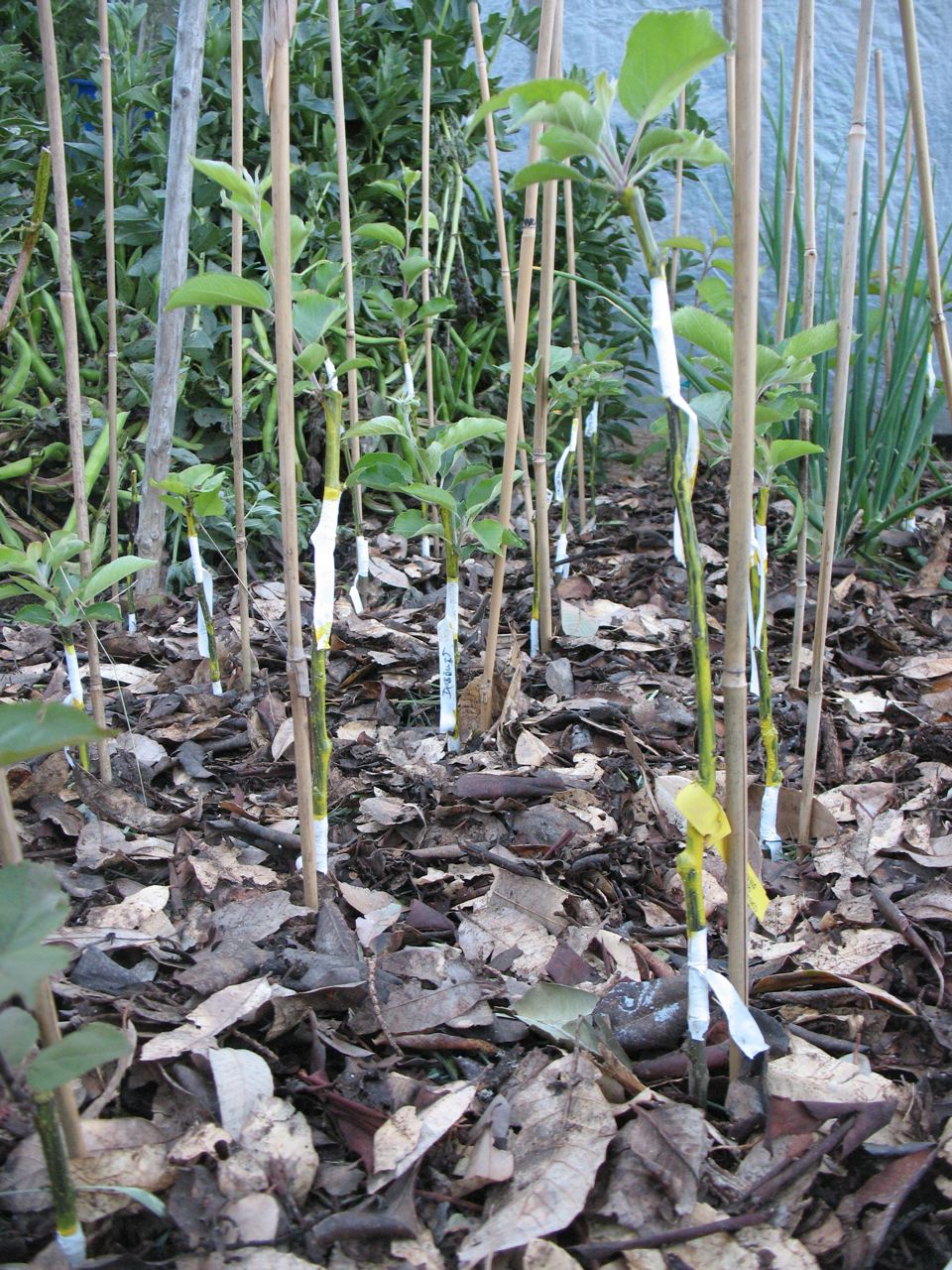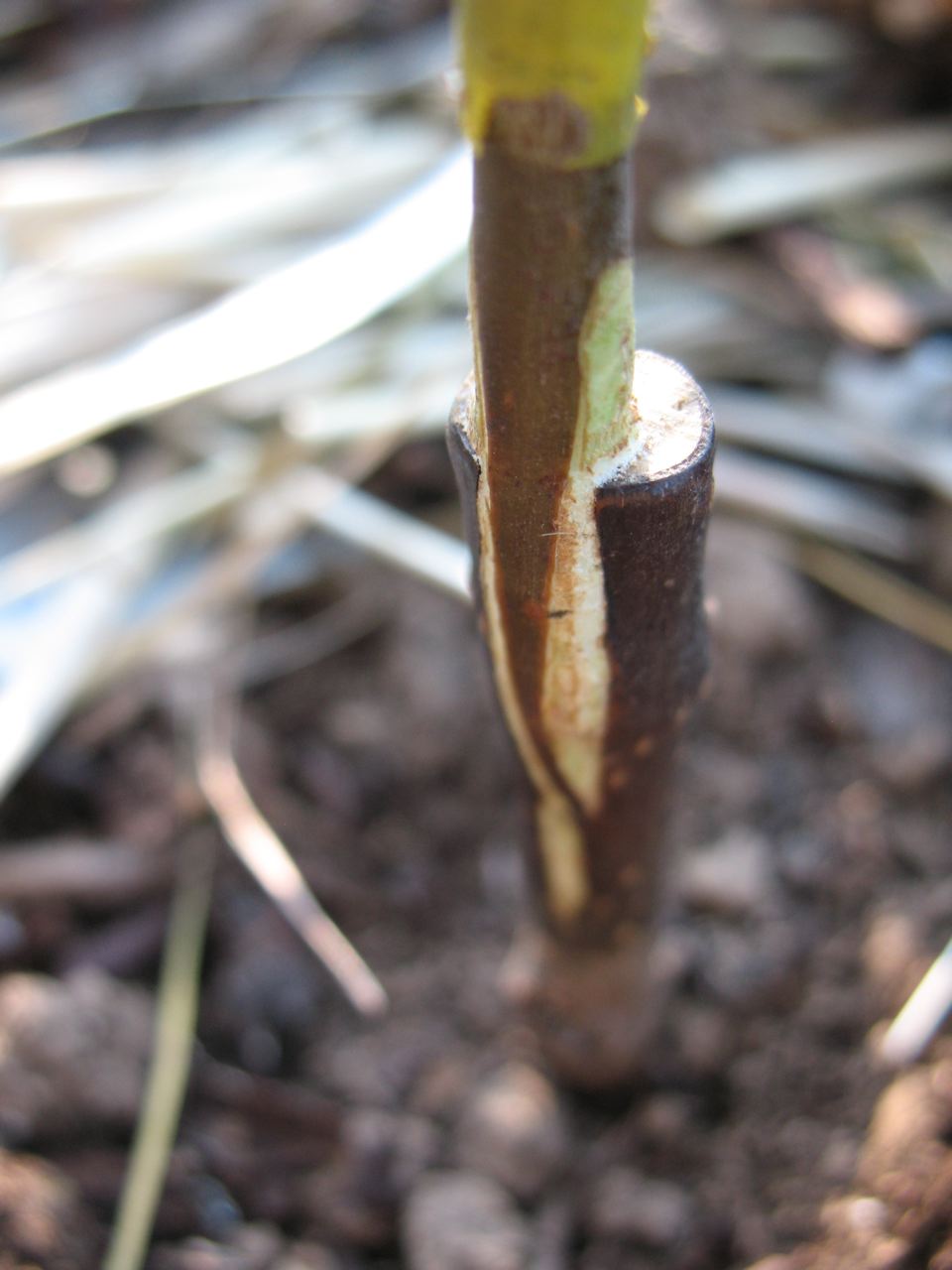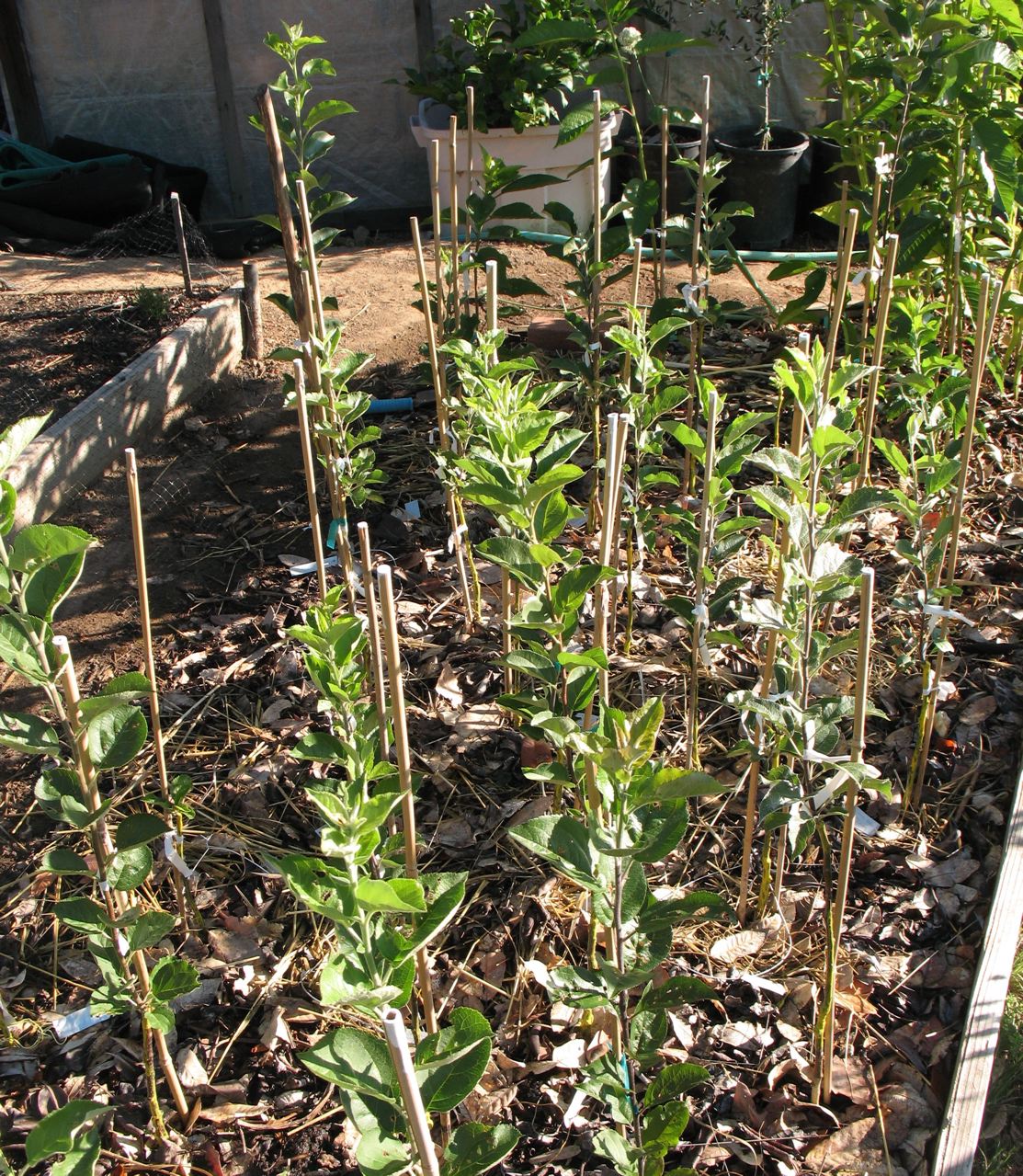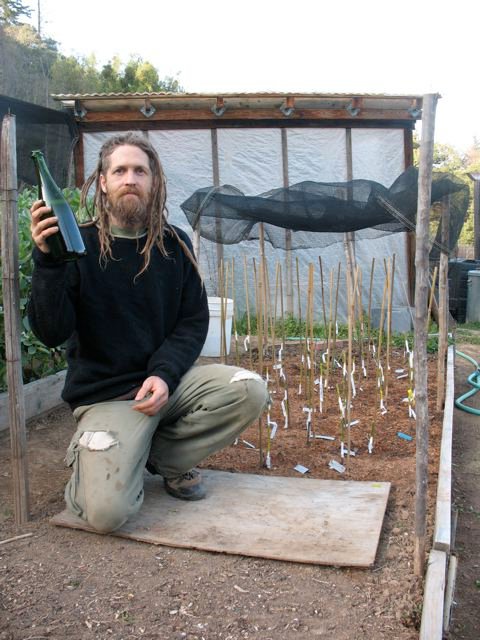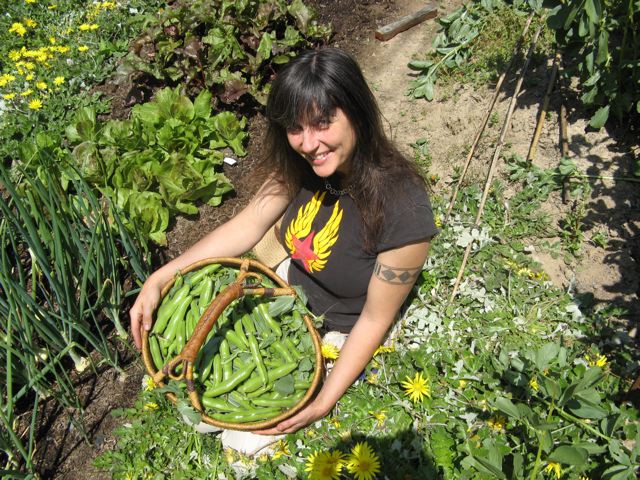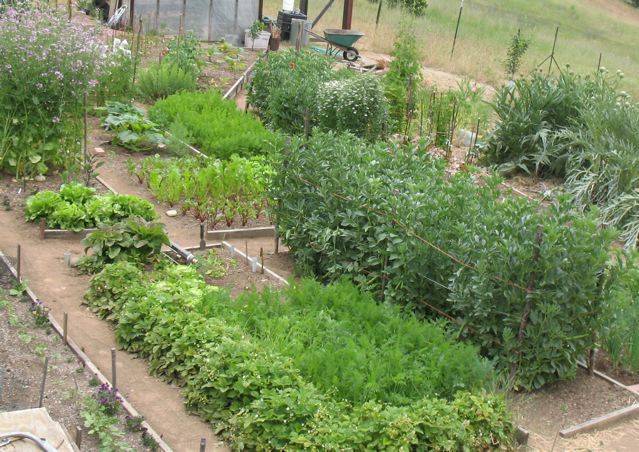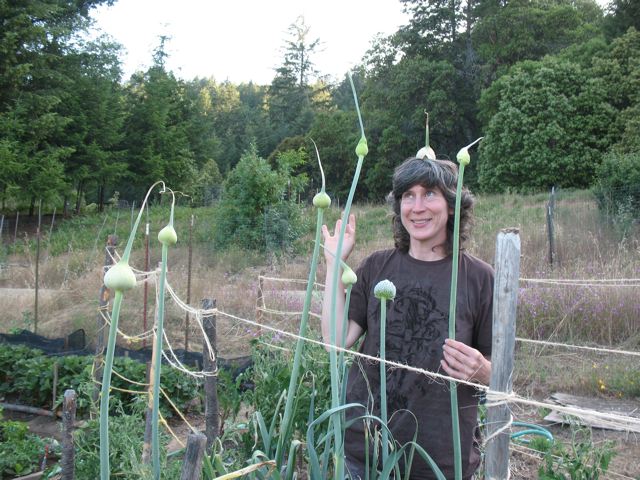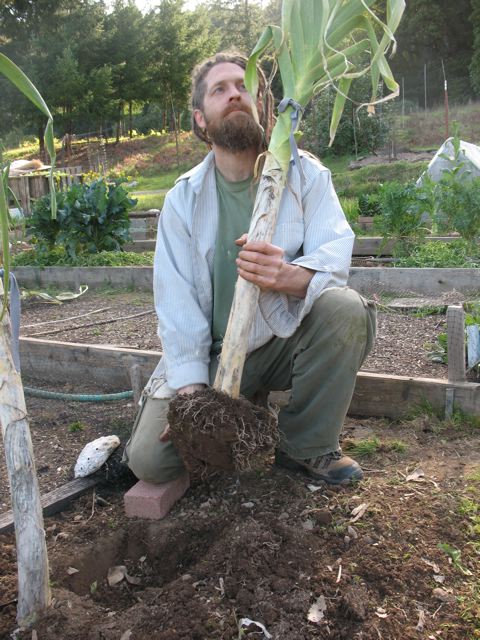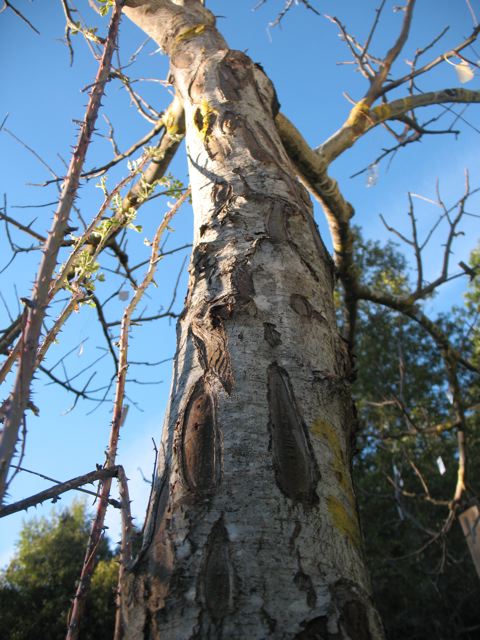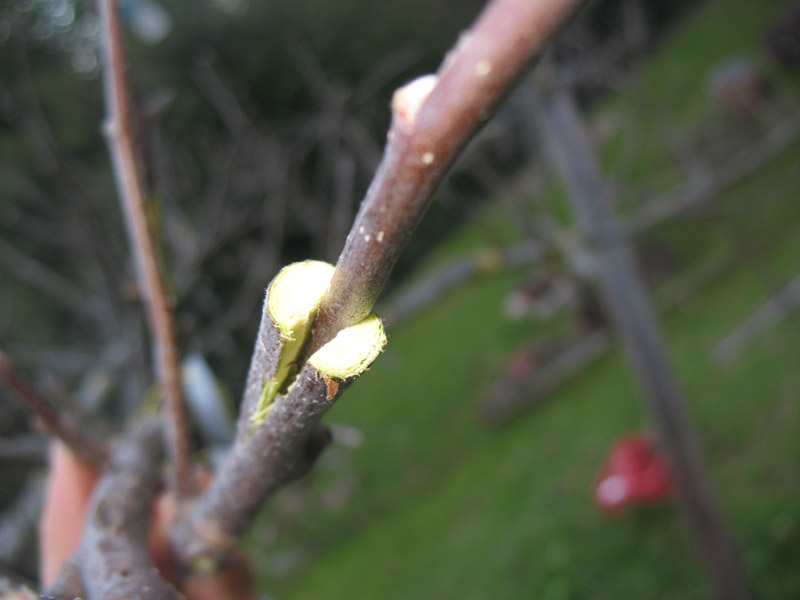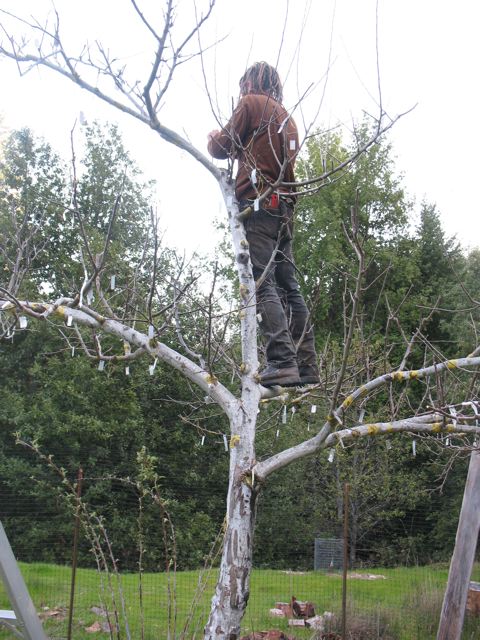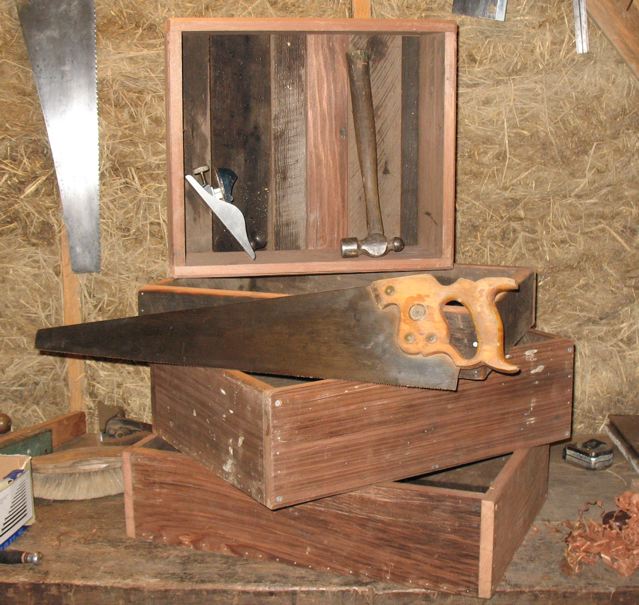We've been planting trees here for 4 years and gearing up to plant about 25 more trees and shrubs in the next couple of months. My goal with almost all the trees is to establish well rooted, hardy, self sufficient, un-spoiled trees and then let them do their thing without irrigation and with minimal intervention otherwise. Most will be pruned yearly, but some won't depending on intended use, location and variety or species. I'd like to record here the methods we've been using in establishment as it seems to be going very well in general and requires only infrequent waterings during the establishment period. Our climate is torrentially wet in most winters and reliably dry all summer.
It's easy to plant a tree, but many trees that are planted fail to thrive or just plain die for lack of follow up care. Fruit trees are expensive and a tree that is established well is going to pay you back in good health and productivity. It's better to plant only a few trees and take care of them than plant a lot and care for them poorly. The methods here are detailed and somewhat intensive, but success is in the details and I'm shooting for long term hardiness and self sufficiency which will save on pampering of the tree later. Old homestead trees around here often live and produce for many years, so I know what I'm shooting for.... low maintenance and medium to high productivity. Water is limited here but, really, water is limited everywhere and the less we all use the better. So, it's ideal to grow stuff without it as much as possible. I may end up irrigating some trees if they don't produce as much as I like, or can't fend for themselves, but I'm hoping good site selection and careful establishment will almost entirely negate the need for supplemental water. We also have to establish trees that are further out than we can get water too and have had quite good luck doing this with the techniques described here.

SITE SELECTION: Land, soil etc.. can only be modified so much. Mostly, we're stuck with what we get. It will pay you back to carefully consider the needs and dislikes of each type of tree to be sure that you plant it in the best spot you have. Also, consider not planting certain tree types at all if they are likely to do poorly in the spots that you have. We have enough diversity and good planting sites to put in a little bit of everything, but not everyone is so lucky. If all you have is swampy area then you should probably avoid cherries no matter how much you might like them as they will almost certainly fail to thrive and are pretty likely to outright die. Some apples, plums and pears though might do just fine or even thrive. No fruit or nut tree really likes to sit in water, so if the area is real low and swampy in the winter, you might consider mounding up some soil to get the crown of the tree above the swampy line. The crown is the most vulnerable part when it comes to fungal growth and drowning.
PREP AND PLANTING: Most of the trees are bare root or started from seed in place. The trees we have seeded so far are walnuts and almonds to be grafted over to named varieties later. I used almond rootstock for it's known drought tolerance and California black walnut growing near Carpathian (english) walnuts for my Carpathian walnut rootstock. Since the black walnuts grew in proximity to Carpathian walnut trees they could cross pollinate and a number of the stocks appear to be Paradox walnut which is a desirable, healthy, fast growing hybrid of Carpathian and black walnut. I wanted to seed these in place to achieve deep natural root systems. I don't know about the almond, but the black walnut has a deep fast growing tap root that I want to stay intact. The suitability and notably diseases resistance of the almond stock is to be seen as time goes on. I got the seeds from bitter almonds. Both were stratified in the ground or in the fridge in damp sawdust, or both, and then planted into a chicken wire cage about 8 inches in diameter and 16 or 18 inches high.
The bare root trees were mostly grafted by myself onto purchased rootstock. I purchased a few trees, but they did relatively poorly in most cases. I don't much like potted trees and avoid them when possible. Grafting your own trees has a lot of advantages including getting the varieties you want, more personal investment in your trees, getting the rootstock you want and, most importantly, the opportunity to get the trees in the ground just after they're dug up which avoids the stresses caused by early digging, long storage and subsequent shipping and delays in planting that can plague purchased bare rooted trees.
Bare root trees are planted into wire baskets as well. Almost everything is here since we have an abundance of voles and quite a few gophers. The cages are only about 14 or 15 inches in diameter and about a foot and a half deep, but they protect the nexus of the root system so that it can survive most attacks. First I used aviary wire which has smaller holes than chicken wire 1/2 inch v.s. 1 inch. But, it is also more heavy duty and maybe more rust resistant. I want the cages to rust away sooner than later to prevent potential choking off of the roots. Having dug up some 2 year old aviary netting and seen no rust at all I was inclined to switch to the lighter weight larger holed chicken wire. I'd actually like some un-galvanized 1/2 inch wire that would begin to rust away in a couple of years, but I don't think that's available. At least with the 1 inch holes it will be longer before the roots have to deal with growing around the wire as it tries to choke them off, and maybe it will rust away before then. I originally used aviary wire on Robert Kourik's recommendation from his excellent book Designing and Maintaining Your Edible Landscape Naturally. Which book is excellent and recommended. I also spoke with him at the Sebastopol fruit wood Scion Exchange and he said he thought the aviary was good and might prevent young gophers from squeezing through and that the roots grow around the wire without too much trouble. Because our gopher pressure here is not all that heavy I've chosen to switch to the chicken wire and so far so good. Your mileage may vary. I would not use hardware cloth as it uses thick wire and is very heavily galvanized so it lasts a very long time in the soil.
The baskets are made from a single piece of 4 foot wide wire folded down in half along the narrower length, then folded in from the sides a couple of times to make a pinched seam on the sides. This makes a flat envelope. Open it up a little and step into it stepping around on the inside to make a flat floor. It will end up kind of square in shape with two little triangular tag ends on the outsides of the cage. Fold these ends under the cage and step inside again to flatten it all down into a squarish floor. I'll try to remember to edit this with the dimensions when I prepare this year's cages, but I think the wire rectangles start out about 4 x 2 or 4 x 2 1/2 feet. They can be made a little bigger or smaller accordingly.


Fold in the edges of the wire basket a couple of times and then step on them to pinch together.
It's generally safest to plant trees at the level they were planted in the nursery row.... usually indicated by a change in color or texture on the trunk. However, easily rooted trees, like those grown from cuttings are often fine to plant deeper. Whatever you do, don't leave a depression in the ground around the trunk of the tree as it can puddle water and drown the trunk or promote fungal growth. Since you will be fluffing the soil as you plant, the tree should end up on a slight mound and be expected to sink in with watering and weathering.
Purchased bare root trees should be soaked in water overnight to re-hydrate them before planting. Be sure that the roots NEVER DRY OUT at any time. If you will be working for a while digging and such, wrap the roots in plastic bags or wet cloth or carry them out in the soaking bucket. Conventional wisdom used to say to dig a big hole and put lot's of amendments in the hole before planting. Conventional wisdom now tends toward digging a hole just large enough for the roots and using no amendments, but amending from the top down after planting. I follow the new school and it sure is a lot easier than digging a big ass hole! I'm sure there's a place for digging big amended holes, but for my purposes, I want the tree roots to have to forage far and deep for water and food. If everything they need is right near the tree, they will hang out there and have lazy roots.
Two important details in digging the hole:
Leave 4 to 6 inches of the wire basket above ground to help a little in discouraging voles and gophers.
Shovels often leave a hard compacted "glaze" of soil on the inside of the hole which can inhibit root penetration. This is especially true of soils with high clay. after you dig the hole to about the right size, break up the sides of the hole with a digging fork or something to expose un-compacted soil.
The soil should not be too wet. Digging in very wet soil destroys the all important soil texture preventing proper drainage and cutting the roots off from air. Try to treat the soil gently as you take it out and put it back in.

A stick shoved through the holes in the wire cage and suspended 2 to 4 inches above the ground level can serve as a handy planting depth guide. Hold the nursery soil line of the tree trunk next to the stick while you fill in the hole. Most often you will need to make a mound in the center of the hole and spread the roots as evenly as possible around the area. prune broken roots to leave a clean cut and poke long roots through the wire and even into the surrounding soil if they are long enough. Don't allow roots to circle the edge of the hole. Fill the hole in deliberately and somewhat carefully pushing soil under the roots as necessary, filtering it down the outsides of the wire basket and so on to make sure there aren't any large air pockets left.

Avoid compacting the soil excessively as the loose, friable structure of soil is important for the respiration of the soil and mobility and health of the plant roots. When everything is filled in, I prefer to sprinkle some sawdust, leaf mould, compost or sand around the tree to prevent soil compaction when it is watered it. Water the tree in well. One thing to avoid is messing with the soil when you water the tree the first time. The structure of very wet soil is destroyed with even the slightest agitation. I sometimes will pour a bunch of the water on the newly planted tree and when the soil is well soaked give the tree one strong shake to fill air pockets and settle the soil. More than one shake though or any mucking about in the soil can result in creating something like a mass of adobe brick around the roots of your plant.
MULCHING: Mulching serves several important functions and would seem as though it could potentially create some problems which I will address from my experience. First, mulching reduces evaporation of water from the soil. it all but stops it actually, so the water leaves the soil only through the plants growing in it... which hopefully is mostly just your tree and the weeds growing right around the edge of the mulch. Secondly, it stops all the plants that would be growing around the tree from drawing up and exhaling all the water in the soil. Thirdly, it prevents the plants that would normally grow there from using nutrients that your tree would benefit from. Fourthly, the organic material in the mulch, including the cardboard, will end up feeding the tree for a long time to come. Voles and Gophers eat roots and bark and they like to hide under stuff like sheets of cardboard handy to their food source. That seems as though it would be a potential problem with sheet mulching. I have a lot of voles here and it does not seem to be a problem. In fact I've come to think of this angle as more positive. Piling up a large amount of organic matter and providing shelter and a moist place during dry times draws in and supports a little ecosystem of activity on and in the soil. Bugs move in and eat the organic matter and each other and leave dead bodies and droppings. Rodents move in and bring more organic matter for nests and food and leave droppings and dead bodies. More insects, salamanders, snakes and lizards are attracted and so on. So, in a real way, the mulch draws in more resources as well as the organisms that break down what is already there. Worms also come to the surface to feed and draw nutrients back down into the soil and other bugs and animals turn over the soil. As far as the negative effects of voles and gophers living under the mulch I've had voles chew up the bark on trees, but nothing else. This is a real problem, but the solution is fairly simple. I buy a few aluminum printing plates from a local printer (these plates are a by-product of printing process and are sold as scrap) and make collars for the trees. These can be left on for years and are weak enough not to strangle the tree if neglected. Honestly, I would put the collars on here with or without mulch until the tree was grown pretty large. Also, I would rather have a tree that is well mulched with no weed growth around it and no collar than a tree with weed growth around the trunk with no collar because there is nothing they like better than making tunnels through the weeds to their feeding sites. I don't know that having the mulch around the trees does not encourage more feeding on the roots underground and outside the cage, and it would take some careful controlled study to prove or disprove that, but fortunately I'm not a scientist! So, I just care about the results and I've had good results. I will say though that gopher pressure here is on the light side compared to many places.. but then I have done this in heavy gopher areas to a lesser extent without any noticeable problems. To tie those thoughts up, I would actually say at this point that the fact that the mulch draws in more life, activity and resources is actually a fifth advantage more than anything else. Finally, each season as the moisture in the soil under the mulch is used up by the tree, the tree roots have to forage deeper and wider for water making for a tough drought resistant root system. Deep watering can achieve a similar effect, and indeed you may be deep watering under you mulch the first couple/few years, but with no mulch you are more likely to have to deep water all summer every year for the entire establishment period creating a roller coaster effect where there is water in the top soil.. then there isn't, then there is again causing the tree to grow new roots to use it... then no water again causing root die back... then water again etc... and that coupled with the disadvantages of weed competition and without the positive effects of mulching.
Another problem that seems evident is that the mulch would actually prevent water infiltration into the soil the following winter. Last winter was very dry. Everyone's springs are still low the following January. I didn't keep track of how much, but however much is was it was enough for the mulched trees. This past summer I watered some two year old trees deeply by sticking the hose under the mulch only once in late summer and they did very well putting on shoots 2 feet and better. Many trees at 3 and 4 years old received no supplemental watering and also did very well. I could foresee prevention of rain penetration being a problem in some very low rainfall areas, but it hasn't been here. Also, there is some infiltration... especially in the second season when the cardboard has become more sunken and broken
One last problem I have had with mulching is the encouragement of perenial weeds. While annual weeds are easily smothered, most areas have at least one perennial weed that not only can find it's way through cracks in the mulch and survive, but will even thrive in the environment of reduced competition. Around here those weeds tend to be Bindweed (wild morning glory), Sheep Sorrel, and Hedge Nettle. I don't have a solution to this problem and have definitely seen not only survival, but proliferation of these plants under mulching over several years. Since these plants are deep rooted and live through the summer, they could offer significant competition for water in our dry summers. Only time will tell to what degree this is a problem.
Another wrinkle I haven't worked out is avoiding generally weedy and noxious growth under the trees as the mulch is allowed to decay. Since the area is basically disturbed, thisles, wild lettuce, prickly annual non-native grasses and the like tend to thrive. Making a transition to a more stable diverse understory as the mulch is allowed to go to seed is something to work on. I have one experiment in progress using Narcissus and Daffodils as an understory. Planted in the mulch in year 3 on 8 inch centers, the idea is to eventually pretty well fill out the whole mulch ring area with crowded bulbs. Since these flowers grow thickly in the cold wet season and die in late spring, it would seem that they might choke out most of the grasses and herbs, but then die back in time to leave the water in the soil to the tree for the rest of the summer. We'll see....

Timing is important with mulching. Bare root season is during plant dormancy when soils are wet. You want to mulch the tree BEFORE the rains stop because wild plants around the tree will rapidly use up the store of water in the soil. I like to spread a bucket of urine (Urine is an awesome fertilizer with lot's of nitrogen, quite a bit of potassium and phosphorus, and tons of other minerals. It is very beneficial to pee around your trees.) and any mineral or other supplements around the tree in a 6 to 8 foot circle before before mulching. Ideally these amendments will be watered in by an inch or three of rain to carry them down into the soil before mulching is carried out. You also want the cardboard to be rained on a few times so that it settles in and hugs the ground surface.

For mulching I use mostly cardboard several layers thick and covered with whatever organic material is handy at least thick enough to obscure the cardboard. The first couple of years I used rotting straw from left from our neighbors' straw bale house construction. The next year their house burned down and we ended up with lot's more straw from that. Then a big ass forest fire came along and lit a fire under our asses to do some clearing around our place. We chipped all the tree trimmings and are on the second year of using that material on top of cardboard. Large sheets of cardboard are ideal. The bigger the better. Hit the furniture and appliance store dumpsters. Trust me when I say that you should remove the packing tape from the cardboard before use... otherwise you will be seeing bits of it for a long time to come blowing around the place. If I use three or more layers of good cardboard, I can generally get two years of weed free area around the tree with only some light weeding on the second year. That is assuming that you haven't got chickens, skunks, dogs, turkeys or whatever tearing the stuff up looking for bugs or just for the pure joy of it. My experience is that after two seasons you have to re-mulch to maintain the area weed free. I have been shooting for at least 4 years of mulched weed free growth per tree which can be achieved with two mulchings. I'm thinking I will do quite a few of them for 6 years, depending on site conditions and tree progress. Apply the cardboard in a 6 to 8 foot circle (6 for the first two years and 8 thereafter is good) up to the edge of the wire basket. Mulch with at least enough top mulch to cover the cardboard visually.

A couple more important steps! Since the root area of a young tree is right around the planting hole and the mulch should only come to the edge of the wire basket, it is very important to prevent evaporation of water from the soil in the area of the planting hole. After cutting the tree back and putting on the metal vole collar, I generally put an inch or more of sand in the collar right around the trunk and either more sand, or preferably some fine organic material like sawdust, old potting mix, leaf mould, compost etc... outside the collar and up to the mulch. It's best if this is 2 inches or more thick.
With this done, I usually dump maybe 1/3 of a watering can of urine (fill rest of can with water to dilute) right on the planting hole area. Follow this with another watering can full of water. Urine contains all soluble minerals and nutrients by definition and gives the tree a ready source of immediately consumable food as soon as it begins to grow feeder roots and root hairs.
Check the tree in about 4 to 6 weeks and again in another 4 weeks or so for any weeds coming up around the planting hole and kill 'em. If one weed grows it will be 100 times bigger than normal and compete with your tree.
FOLLOW UP: Your tree is now tucked in tight, provided with ready food, protected from hungry and thirsty "weeds" and has a bank account of organic matter that will slowly filter into the soil and create longer term fertility, you can relax... mostly. Aside from a couple of weed checks the first year, you will also have to weed check every year thereafter. I make the rounds and weed all the trees in early winter and then again in late winter. There will probably be weeds growing in the mulch, but most of them have roots growing in the mulch above the cardboard only and can't find a way into the soil so they will eventually just die. Look for plants growing in the mulch that look extra healthy next to the mostly stunted ones- these have found their way into the soil below the mulch. Pull them out. Keep an eye on the trees through spring looking for missed weeds.
WATERING AND FERTILIZING: The first year I'll apply dilute urine and water right around the planting hole area as the roots are not yet widespread... and it's just easier. Do this as little as you can, but don't let the tree growth stop too much. If I'm going to water at all (watering is not much of an option for trees that are further out) I'll do it maybe three times through the summer at the most. In year two and thereafter I still apply urine around the tree trunk/planting hole area during the late fall and or late winter by either saving it in buckets or just walking around peeing on them systematically through the wet season. After the first year though I water by sticking a hose under the mulch for a while in a couple different places rather than putting it in the planting hole area. Just make sure that when you do water you put on a lot of water infrequently rather than small bits frequently.
RE-MULCHING: I apply soil amendments like oyster shell (for acidic soils), minerals, chicken feathers, urine or whatever you got on top of the old mulch before adding new cardboard and mulch for the next mulching in the third year. If you apply this stuff well before mulching it can have a chance to be washed into the soil some before you cover it over and prevent rain infiltration.
ALTERNATIVE MATERIALS: I strive here to reduce the amount of external inputs to the grounds. I buy very little amendments for the garden or instance and try to rely on very local materials like leaves and grass for compost etc... I have experimented with using locally available bio-mass for mulching fruit trees and it can work just fine. I've used rocks, slabs of old fir bark of all sizes, rotten wood, grass stems and leaves. This stuff can work fine, but will require a lot more weeding and will sink into the landscape pretty quickly. One almond/peach tree that was done this way is now on it's own and has lush dark green plant growth all around the base from all the extra fertility provided by the decaying mulch and the organisms that live in it. Put on thick enough, leaves and grass should smother I like cardboard though and feel that it's worth the effort of dragging it up here on every town trip during the winter. Then again, I have a lot of trees. If I had only a handful I might be more inclined to use leaves and bark and accept the extra weeding it can entail.
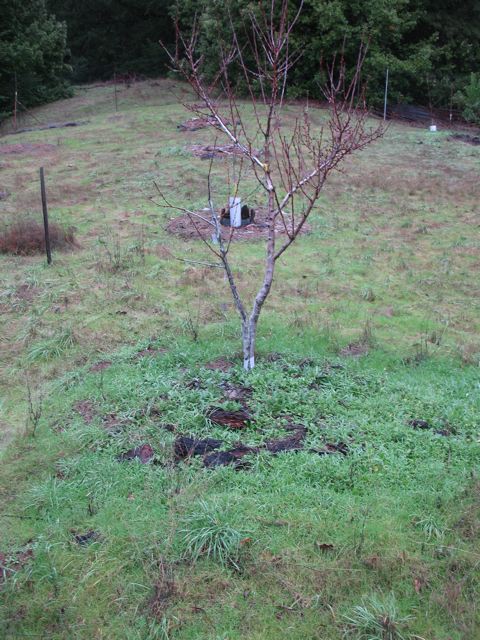
Pruning and training trees is another subject altogether, but I hope this maybe not so little tutorial sets some people off to a good start. It may seem pedantic but, again, success is in the details and knowing why to do or not do something gives you more scope on a problem allowing for greater flexibility in creative adaptation.


